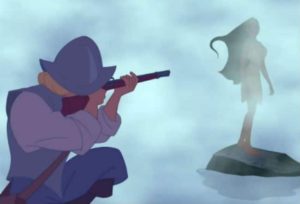 In 1995, when my son James was seven years old, I took him to the movie theatre to see Walt Disney’s “Pocahontas.” Not surprisingly, he loved it. But walking through the parking lot afterwards, he told me there was something he didn’t understand.
In 1995, when my son James was seven years old, I took him to the movie theatre to see Walt Disney’s “Pocahontas.” Not surprisingly, he loved it. But walking through the parking lot afterwards, he told me there was something he didn’t understand.
“What’s that?” I asked.
“Which ones were the bad guys?”
An interesting conversation ensued. Seven-year-olds think deeper than we often give them credit for. I’m not sure James analyzed or even paid attention to “Savages! Savages!,” the movie’s truest and most disturbing song. But he understood there were two sides to the story of the “paleface” settlers’ arrival in the New World.
When a controversy like the one currently surrounding the Algood Middle School “Redskins” mascot arises, I’m compelled to ponder how my perceptions about Native Americans were shaped. I grew up watching TV westerns, where Indians were usually the bad guys or, like the Lone Ranger’s Tonto, loyal but inferior sidekicks. Then, in 1970, I saw “Little Big Man” and the scales fell away from my eyes.
Some of the scales, anyway. I wasn’t totally enlightened. As a diehard Atlanta Braves fan, I loved Chief Noc-A-Homa. From 1966 until 1985, this Native American mascot began the festivities at every home ball game with a dance on the pitcher’s mound. Then he sprinted to his teepee in an unoccupied section of the left field bleacher seats. Whenever a Braves player hit a homerun, Chief Noc-A-Homa set off smoke signals and emerged from his teepee to celebrate. In the early 1980s, the Braves organization began to receive increasing criticism for their dated and racially insensitive mascot. Chief Noc-A-Homa was retired in 1986. I must confess that, for a time, I missed him.
But now that I know better, I try to do better. I know that conquerors write history. Conquerors perpetuate stereotypes. Conquerors call the conquered whatever names they choose.
Though the term “Redskin” was originally used by both indigenous people and early white settlers simply to differentiate between the races, it quickly took on a negative connotation. Indians stood in the way of what the white man wanted—land and all the riches it contained. If “Redskins” were viewed as less human than white people, or not human at all, there was far less white guilt when they were removed or exterminated. An 1863 advertisement in a Minnesota newspaper proclaimed that “the state reward for dead Indians has been increased to $200 for every redskin sent to purgatory. This sum is more than the dead bodies of all the Indians east of the Red River are worth.”
Why then, over the years, have so many schools and sports teams chosen Native American mascots?
Troy Smith, Associate Professor of History at Tennessee Tech whose area of expertise is Native American Studies, contends it’s a manifestation of the deeply rooted (non-indigenous) American culture to absorb Native identity and hold on to it stubbornly, as a marker of true “Americanness.” This compulsion, he says, has always required the general public to relegate Indians to a semi-mythical past whose legacy “we” are carrying on. “I have been witness,” Smith writes, “to several efforts to remove American Indian mascots, and each one has been a monumental battle with herculean resistance from the community.”
That battle rages on here in Putnam County, despite the School Board’s unanimous vote earlier this month that “Redskins” will remain the mascot at Algood Middle School. In next week’s column, I’ll share some of what folks on both sides of the issue have to say about it. And I’ll tell you what I think.
(Jennie Ivey is a Cookeville writer. E-mail her at [email protected])